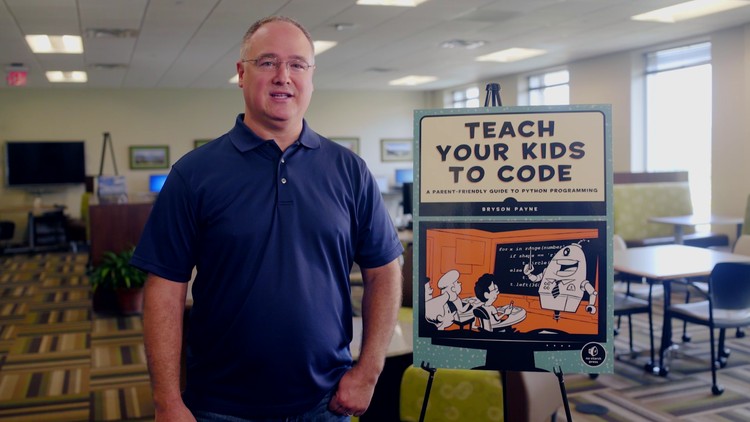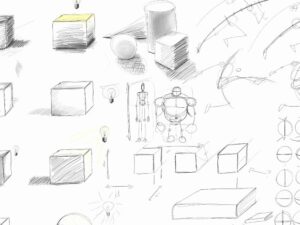Teach Your Kids to Code: Learn to Program Python at Any Age!
- Description
- Curriculum
- FAQ
- Reviews

Join over 38,000 students from 182 countries learning Python (and teaching it)!
Now includes coding for Chromebook users! Teach yourself (and your students) to code fun, colorful apps and games in Python, the powerful programming language used at tech companies and in colleges worldwide. Learn coding step-by-step from Computer Science Professor Dr. Bryson Payne, author of the Amazon #1 New Release and Top 10 Best Seller, Teach Your Kids to Code: A Parent-Friendly Guide to Python Programming (No Starch Press).
Updates: New videos added to section 1 for coding on Chromebook, iPad and more!
Give Your Kids a Huge Advantage in a High-Tech World
-
Quickly master new problem-solving skills in Python with colorful, fun examples
-
Teach beginners to code using Turtle graphics, with text-based games and apps for older learners
-
Build your own playable games and create beautiful graphics
-
Learn the basics of coding, from variables to loops and functions, with interactive, engaging apps
This is the kind of course you can enjoy with your kids!
Packed with fun examples, colorful graphics, and easy-to-follow plain English instruction, Teach Your Kids to Code is the course parents, teachers and students can enjoy together, as they build one of the top job skills of the 21st century! Python is a great first language for beginners, but it’s powerful enough to be used in companies from Google to IBM.
I designed this programming course to be easily understood by absolute beginners, with example code I used with my own students up to college freshmen.
Quick, hands-on lessons will get you coding your own apps from scratch in minutes. Over 100 video lectures and six and a half hours of content in short, 2-to-8-minute videos will give you the practice you need to master the powerful new skill of coding.
Everything you need to get started right away
Complete with working code downloads and high-definition videos, you’ll be able to work alongside a professor with 22 years’ teaching experience and over 30 years of programming knowledge. You’ll also receive a Certificate of Completion upon finishing the course.
No Risk: Preview videos from Sections 1, 2, and 4 now for FREE, and enjoy a 30-day money-back guarantee when you enroll – zero risk, unlimited payoff! And, we’ve made this course easy to afford at just $30 so parents and students can get started now!
Sign up for this course and get started coding today!
* Programming Challenge Solutions added to all 7 Sections, plus new Bonus videos, including a new one with my son, Alex! New Turtle Gallery code and Q&A video added this month– keep the feedback and questions coming! Thanks! *
Praise for Teach Your Kids to Code:
“Inspired” – This is an inspiring course taught by an inspired teacher. The examples are well-chosen — demonstrating principles through engaging, colorful projects rather than by teaching abstract principles first. While I wish the instructor weren’t quite so repetitiously exuberant, this is at worst a minor stylistic blemish and might even be a plus for kids viewing it. — Kent Osband, Udemy student
“Excellent path into Python” Not just for kids…use this course as the perfect Python primer. Clear examples, that build quickly into programs, leading to learning challenges. Bryson’s delivery is well paced and good fun. — Sean Jon Darcy, Udemy student
“Dr. Bryson Payne is a computer scientist and professor of the highest caliber, and with Teach Your Kids to Code, he brings the power of computers within easy reach for learners young and old.”—Dr. Antonio Sanz Montemayor, Informatics Professor, Universidad Rey Juan Carlos, Spain
“The concepts in Teach Your Kids to Code can help any young person enhance their college prospects and expand their career opportunities.”—Dr. Raj Sunderraman, Department Chair of Computer Science, Georgia State University
[For the Book version on Amazon] “Dr. Payne set us on the path that led us to our dream jobs! With Teach Your Kids to Code, he’s providing parents and teachers everywhere the chance to do the same for the next generation of creative problem-solvers.”—Shah and Susan Rahman, Riot Games
-
1Welcome and Introduction
What is coding, and why is it good for your kids? Plus, how to get the most from this course.
-
2Installing Python and Getting Started
How to download and install the FREE Python programming environment step-by-step
-
3NEW: Installing Python 3.6 and Getting Started
How to install the NEW Python version 3.6 on a Mac.
-
4Update: Installing Python 3.6 on Windows PC's
How to install the NEW Python version 3.6 on Windows PC's.
-
5Update Video: Using Python 3.5 on Windows
Bonus Q&A Video: Students AJ & Paula asked for a video showing Python installation on Windows and whether the newer Python 3.5 would work for all the lessons in the book and online course - this video answers both questions (spoiler alert, it's a YES!) - thank you, AJ & Paula, for posting great questions!
-
6Writing Your First Program in Python
Write and save your first Python program.
-
7Running and Modifying Programs in Python
Run Python programs, and change them to make them even cooler!
-
8Extra App: NiceHexSpiral.py
Run and modify a fun, visual program that draws a multi-color spiral.
-
9Coding Python on Chromebook!
Chromebook update: Use the free web site https://repl.it to code in Python on your Chromebook, iPad, or any device with a web browser - no software installation required!
Repl.it is also a great option for students at school who don't have administrator privileges to install software. Surf to https://repl.it, create a free account and verify your email, and start coding in Python now!
-
10What You Can Do Now
By the end of Section 1, you should:
- Have a fully functional Python environment and text editor (IDLE)
- Be able to enter programming commands directly into the Python Shell
- Be able to write, save, run and modify short Python programs in IDLE
- Be ready to try more advanced programs in Section 2
-
11Programming Challenges - Practice What You've Learned
The simple YourName.py app has all the necessary components for us to build a much more interesting program, like the old-fashioned Mad Libs® word games.
Try the challenge problems at the end of each section to extend your learning even further, and write code that's even cooler! -
12Section 1 Programming Challenges: MadLibs 1 & 2!
At the end of each section, you can practice what you've learned - and make even cooler programs - by trying a couple of challenges. Try them on your own, and if you get stuck, sample answers are provided.
-
13Step-by-Step Python 3 Setup for PC, Mac or Linux (with Screenshots)
Quick, clear how-to for installing Python on PC, Mac or Linux, with screenshots!
-
14Intro to Turtle Graphics in Python
Introduction to Turtle graphics in Python, and an overview of what you'll learn in Section 2.
-
15SquareSpiral: Our First Turtle Program
Write a 5-line Turtle program in Python from scratch! Draws a hypnotizing square spiral on your screen!
-
16Turtle on a Roll: Building A Winding Spiral
Change your program to make it even cooler! Modify the square spiral to draw a winding spiral staircase/pyramid shape!
-
17Loop the Loop: Creating a Circle Spiral
Use the circle() function in Python's Turtle graphics to draw circles of varying sizes for a cool pattern!
-
18Adding Color to Your Turtle Drawings
Add color to your turtle creations using the pencolor() function.
-
19Painting a Four-Color Spiral
Use a list of colors to paint a four-color square spiral!
-
20Changing Background Colors
Change the background color of your turtle screen by using turtle.bgcolor().
-
21One Variable to Rule Them All...
Store a simple number value in a variable and use it in a program to change shapes easily.
-
22Section 2 Programming ChallengesAt the end of each section, you can practice what you've learned - and make even cooler programs - by trying a couple of challenges. Try them on your own, and if you get stuck, sample answers are provided.
-
23S2P1 Programming Challenge Solution: 10-color spiral!
Challenge 1 Color Spiral 10
-
24S2P2 Programming Challenge Solution: How Many Sides?Challenge 2 Color Spiral Choice
-
25S2P3 Programming Challenge Solution: Rubber Band BallChallenge 3 Rubber Band Ball
-
26Intro to Variables: Where we keep our stuff
An introduction to variables in Python, and an overview of what you'll learn in Section 3.
-
27Numbers and Math in Python
Create your own variables using strings, and store user input in string variables.
-
28Python Numbers and Operators
Use basic math operators in Python to perform calculations.
-
29Math in the Python Shell
Perform math operations using the Python Shell.
-
30Syntax Errors: What did you say?
Understand and correct syntax errors - when your computer can't understand you in Python.
-
31Variables in the Python Shell
Use variables to store numbers and perform calculations in the command-line Python Shell.
-
32Programming with Operators
Write a program using Python math operators to figure out the total cost of a pizza order, including sales tax.
-
33Strings: The real characters in Python
Write a program that stores strings of text as variables, and says your name on the screen 100 times!
-
34Improving Our Color Spiral with Strings
Write colorful text on the Turtle screen, and create a multicolor spiral of your name!
-
35Lists in Python
Store values in a list or array, and use a list of colors to draw in a colorful pattern on the screen.
-
36Python Math App: Python does your math homework!
Let Python do your Math homework! Ask for input, evaluate expressions, and do a variety of math functions interactively in your own program!
-
37Section 3 Programming ChallengesAt the end of each section, you can practice what you've learned - and make even cooler programs - by trying a couple of challenges. Try them on your own, and if you get stuck, sample answers are provided.
-
38S3P1 Programming Challenge Solution: Circle Spiral Input!Challenge 1 Circle Spiral Input
-
39S3P2 Programming Challenge Solution: Color Me SpiralledChallenge 2 Color Me Spiralled
-
40Loops are Fun: You can say that again!
Introduction to loops in Python, and an overview of what you'll learn in Section 4.
-
41Building Your Own FOR Loops
Learn to code faster and cleaner using loops to repeat a set of statements as many times as you wish!
-
42Using a FOR Loop to Draw a Rosette
Build your own for loop from scratch to create a beautiful rosette shape with four circles!
-
43Modifying a FOR Loop
Modify a for loop to draw rosettes with 6 and 10 circles each!
-
44Adding User Input in Turtle: Rosette Gone Wild!
Ask the user for input using GUI windows in Turtle! Let the user decide how many circles to draw on the screen!
-
45Special Guest Lesson: Alex's Colorful Rosette Loop
A colorful bonus program from my oldest son, Alex (he was 5 when he came up with this!). Draws two sets of overlapping rosettes in red and yellow on a black background.
-
46The WHILE Loop: 'Til it ain't so!
Create your own while loop to repeat while a condition is True or until the condition is False.
-
47A Family Spiral
Build a colorful spiral using the names of everyone in your family! Create empty lists and add to lists using the append() function in Python.
-
48Multi-Spiral: Spiral goes viral!
Draw a psychedelic spiral of spirals using nested loops (a loop inside another loop)!
-
49Section 4 Programming ChallengesAt the end of each section, you can practice what you've learned - and make even cooler programs - by trying a couple of challenges. Try them on your own, and if you get stuck, sample answers are provided.
-
50S4P1 Programming Challenge Solution: Spiral Rosettes!Spiral Rosettes
-
51S4P2 Programming Challenge Solution: Viral Family Spiral!Challenge 2 Viral Family Spiral
-
52Intro to Conditions: What If?
Introduction to conditional expressions in Python, and an overview of what you'll learn in Section 6.
-
53If Statements
Use an if statement to make decisions using conditional expressions.
-
54Comparison Operators
Use conditionals and Boolean expressions to control program flow.
-
55If Example: Old Enough
Write conditional expressions using comparison operators (<, >, ==, !=, <=, >=) in Python.
-
56Else Statements
Use if-else statements to choose between two alternative program paths.
-
57Polygons or Rosettes
Use conditionals and user input to let the user decide what shapes to draw!
-
58Even or Odd
Test a variable to see if it is odd or even using the modulo operator, %. Draw a picture with different odd and even shapes!
-
59Elif Statements
Write if-elif-else statements that select from among a number of options.
-
60Complex Conditions: And's, Or's, & Not's
Use and and or to test multiple conditions at once.
-
61Secret Messages: The Caesar Cipher
Learn to manipulate strings using .upper() and .lower(), and use ord() and chr() to convert characters into their ASCII numeric equivalents and back again!
-
62Encoder Decoder Program
Build your own secret message encoder-decoder program to send secret messages to your friends!
-
63Section 5 Programming ChallengesAt the end of each section, you can practice what you've learned - and make even cooler programs - by trying a couple of challenges. Try them on your own, and if you get stuck, sample answers are provided.
-
64S5P1 Programming Challenge Solution: Rosettes and Spirals!
Challenge 1 Rosettes And Spirals
-
65S5P2 Programming Challenge Solution: Encoder Decoder Key!
Challenge 2 Encoder Decoder with a Custom Key
-
66Intro to Random Numbers and More in Python
An introduction to the random module in Python, and an overview of what you'll learn in Section 6
-
67A Guessing Game
Build a high-low guessing game to guess a random number between 1 and 10, or 1 and 100!
-
68Colorful Random Spirals
Pick a random color from a list in Python.
-
69Canvas Size and Coordinates in Turtle Graphics
Get the size of the turtle screen, and understand turtle (x,y) coordinates.
-
70The Random Spiral Program
Wow! Create 50 (or more!) spirals of random colors and sizes at random locations all over your screen to create a beautiful picture and understand random functions!
-
71Rock-Paper-Scissors
Build a complete Rock-Paper-Scissors game to play against the computer, using the random module in Python!
-
72Dealing Cards
Learn to create a playing card from a standard deck, complete with a face ("Two" through "Ace") and suit (clubs, diamonds, hearts, spades).
-
73Comparing Cards
Compare the value of two cards by using the .index() function.
-
74The Game Loop to Keep It Going
Use a while loop and input to create a game loop that asks the user whether they'd like to play again.
-
75Our Finished High-Card Game
A fun, playable random High Card game, just like the children's card game War!
-
76Rolling Dice
Learn to simulate the rolling of dice using the random module in Python.
-
77Testing for a Yahtzee!
Sort items in a list with the .sort() function, and test for a Yahtzee! in our dice program.
-
78Our Finished Five Dice Game
A complete Yahtzee-like program that tells whether you rolled three, four, or five-of-a-kind! Yahtzee!
-
79A Colorful Kaleidoscope
Move the turtle to random locations, and understand coordinate reflections across the x and y axes.
-
80Section 6 Programming ChallengesAt the end of each section, you can practice what you've learned - and make even cooler programs - by trying a couple of challenges. Try them on your own, and if you get stuck, sample answers are provided.
-
81S6P1 Programming Challenge Solution: Kaleidoscope v2.0
Challenge 1 Kaleidoscope v2
-
82S6P2 Programming Challenge Solution: Kaleidoscope v3.0
Challenge 2 Kaleidoscope v3
-
83S6P3 Programming Challenge Solution: WAR!
Challenge 3 War Complete








